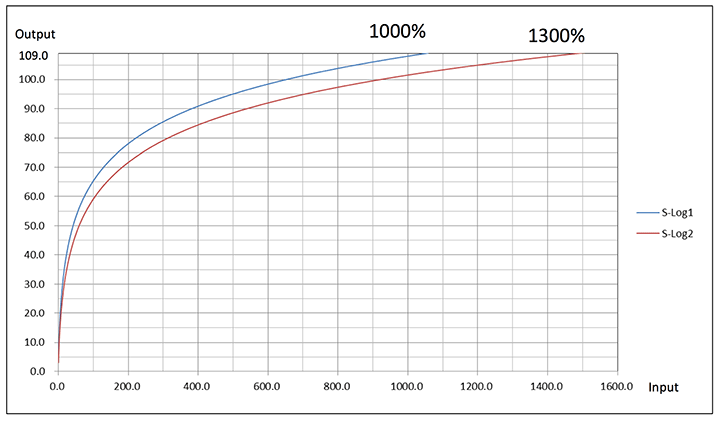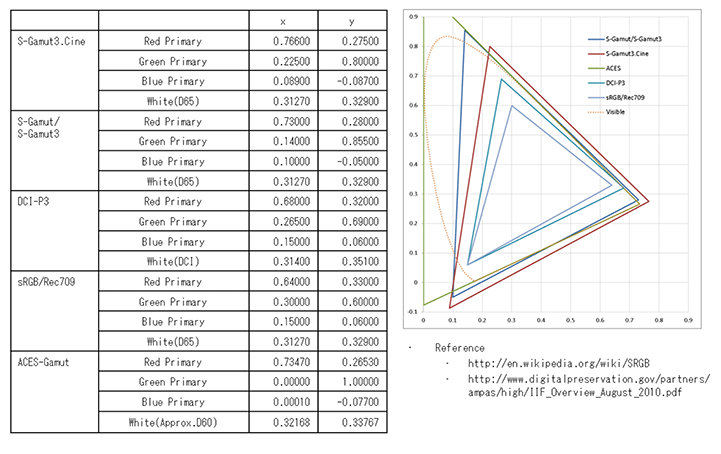Scene Linear Workflow/ACES is based on digital images that faithfully represent the light of real scenes (scene linear). Therefore, by using a subject with a known reflectance (e.g., 18% gray chart) as a reference, all digital images can be represented in terms of reflectance. For example, the SONY F65 digital cinema camera can record as digital data light with a reflectance of up to 1300% with reference to an 18% reflectance. Nowadays, the light data thus recorded can be easily retrieved as scene linear/ACES images in OpenEXR format via software*1 and IDT (Input Device Transform) provided by SONY. Recording real-world light as reflectance and converting it to a digital image is one of the fundamental and important technical elements in building a scene linear workflow. So, how did we get to the point where scene linear/ACES data can be extracted from the camera? Here we will take a look at SONY’s digital cinema cameras to find out.
(“SONY”), a Japanese developer of video equipment for broadcasting, has been highly acclaimed for its technology since 1972, winning numerous Emmy Awards®, the most prestigious awards in the broadcasting industry. In 1999, SONY succeeded in developing and commercializing HD 1080p/24P system technology, and the HDW-F900 HD 1080p/24P camcorder, which was released in 2000, was the basis for the Panavised F900 camcorder released by Panavision, Inc. The film industry, which SONY entered, has a decidedly different workflow from the broadcast industry, and color grading is performed at the final stage of the entire process. The color grading is done at the final stage of the entire process. In addition, the shooting data requires a wide dynamic range comparable to that of motion picture film. On the other hand, there were also technical limitations in encoding to 10-bit, the standard for video equipment. SONY has therefore launched a new function called “User Gamma” to maximize the dynamic range of the camera within these technical limitations. This tool allows users to create a function that converts the light data received by the camera’s image sensor (linear space) into their own gamma space. This user gamma is used by many post-production experts in Japan and abroad, and some post-production companies have begun to sell this unique function. In 2007, SONY took advantage of its user gamma know-how to develop S-Log (now renamed S-Log1), a gamma space that combines elements of color grading and monitoring, and implemented it in the SONY F23 and F35. S-Log is a function to convert between scene linear and 10-bit code values. In parallel, the dynamic range of the F23 and F35 has increased from a maximum of 450% in the F900 to approximately 800% (S-Log1, approx. 12.3 stops), and has further increased to approximately 1300% (S-Log2, approx. 14.0 stops) in the F65, which finally rivals motion picture film. The 2013 F65 update will bring the F65’s image quality on par with that of motion picture film. In 2013, the F65 was updated to enable direct output from the camera in ACES (ACESproxy standard*3 ).

By the way, the Pickford Film Research Center of the Academy of Motion Picture Arts and Sciences ( AMPAS ) in Los Angeles is still holding regular meetings on the theme of ACES ( Academy Color Encoding System ) organized by AMPAS. In addition to color scientists from Hollywood post-production companies, Kazuo Endo of SONY participates in these meetings to research the development status of ACES and to discuss the next generation of the system. As a result of SONY’s participation in this regular meeting, SONY conducted a demonstration experiment for the standardization of ACESlog3 at the Digital Motion Picture Center ( DMPC )4 located in Sony Pictures Entertainment’s facility. In addition, Jeremy Selan, an engineer at Sony Pictures Imageworks and developer of OpenColorIO*5 , implemented IDT for F65 in OpenColorIO based on information provided by SONY. These activities of SONY have been a major contribution to ACES. Note that these regular meetings are still run by corporate and individual volunteers, and any patent applications based on the technology shared here are prohibited. There are many such volunteer-based gatherings in Hollywood, including the 2012 Image Control Assessment Series (ICAS) hosted by the American Society of Cinematographers (ASC) and the Producers Guild of America (PGA), where more than 200 volunteers gathered to actively evaluate cameras on ACES. More than 200 volunteers gathered to actively evaluate cameras on the ACES. Although color gamut is originally derived from the image sensor, the wide color gamut (S-GAMUT) of the F65 CMOS sensor developed by SONY was highly evaluated at ICAS for its accuracy in reproducing colors in highly saturated areas such as neon tubes.

S-Gamut3.Cine/S-Log3 and S-Gamut3/S- Log3 テクニカルサマリー V1.0
As we have seen above, the digital cinema cameras created by SONY have been used in the film industry and have evolved in response to the industry’s strict requirements. Finally, it is now possible for anyone to easily extract scene linear/ACES data directly from a digital cinema camera. It should be emphasized that the free contributions of vendors and color scientists such as SONY are behind this development, and it is also true that, apart from SONY, Mitsuhiro Uchida of FUJIFILM Corporation is the only Japanese who participates in the regular ACES meetings mentioned above. While the developers have been making progress, the filmmakers have benefited greatly from ACES, which has improved the quality of filmmaking and simplified the process. In the future, users (i.e., filmmakers) will be required to actively disseminate information and provide feedback. In Japan, McCrea Corporation led an ICAS-like camera evaluation in February 2014. *6 Although smaller in scale than ICAS, the collection of new camera evaluation data targeting VFX is a significant achievement. *7 When these activities in Japan are fed back to the rest of the world, it will be a true contribution to SONY, which has been supporting ACES.
1) SONY RAW Viewer『RWV-10』
https://www.sony.jp/cinealta/support/download/RAW_Viewer.html
2) “ HD24P Cinealta 『Panavised F900』 2004 Emmy Award ”
http://www.sony.co.jp/SonyInfo/News/Press/200409/04-046/
3) Academy Color Encoding System Developer Resources – Documentaion
http://ampas.github.io/
4) Digital Motion Picture Center – Sony
http://pro.sony.com/bbsccms/ext/Cameras/CineProduction/DigitalMotionPictures/
5) OpenColorIO – OPEN SOURCE COLOR MANAGEMENT
http://opencolorio.org/
6) Maclay Co., Ltd. led a camera assessment activity centered on ACES in February 2014. It was conducted at Rikkyo University’s Niiza Studio over a period of two days, including a preliminary experiment. A total of five cameras were assessed, including SONY F65, SONY F55, RED Epic, ARRI ALEXA XT, and ARRIFLEX 435 ( KODAK VISION3 200T ) film cameras.
For inquiries about camera assessment activities, please contact: Imaging Technology Division, Ray Inc.
Eiji Takahashi, Maclay Sales Department
Technical cooperation: Fujifilm Corporation, Logoscope Corporation, Yasuhiro Kato (compositor)
Facility cooperation: Rikkyo University, Department of Imaging and Physical Sciences, Faculty of Modern Psychology
